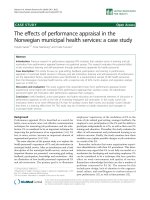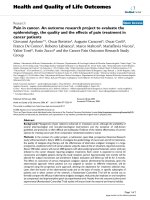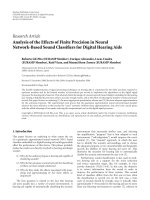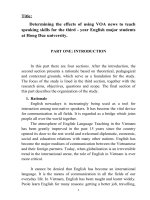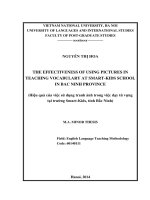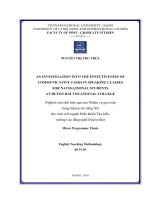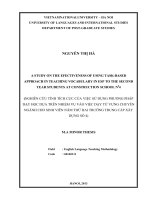the effects of using flashcards in teaching vocabulary to young learners in large classes
Bạn đang xem bản rút gọn của tài liệu. Xem và tải ngay bản đầy đủ của tài liệu tại đây (1014 KB, 118 trang )
MINISTRY OF EDUCATION AND TRAINING
HO CHI MINH CITY OPEN UNIVERSITY
GRADUATE SCHOOL
THE EFFECTS OF USING FLASHCARDS IN TEACHING VOCABULARY
TO YOUNG LEARNERS IN LARGE CLASSES
A thesis submitted in partial fulfillment of the requirements
for the degree of Master of Arts in TESOL
Submitted by NGUYEN TRONG QUYET
Supervisor: Dr. NGUYEN NGOC VU
Class: MTESOL016A
Student Code: 1681401110018
Major Code: 60140111
Ho Chi Minh City, August 2018
STATEMENT OF AUTHORSHIP
I certify that the thesis entitled “THE EFFECTS OF USING FLASHCARDS IN
TEACHING VOCABULARY TO YOUNG LEARNERS IN LARGE CLASSES” is my own
work.
Except where reference is made in the text of the thesis, this thesis does not contain
material published elsewhere or extracted in whole or in part from a thesis by which I have
qualified for or been awarded another degree or diploma.
No other person’s work has been used without due acknowledgement in the main text of
the thesis.
This thesis has not been submitted for the award of any degree or diploma in any other
tertiary institution.
Ho Chi Minh City, August 2018
NGUYEN TRONG QUYET
i
ACKNOWLEDGEMENTS
I would like to express my special thanks to the contribution of those who supported and
encouraged me during the time I worked on this thesis. Without their help, I could hardly
complete this research.
Firstly, I am particularly grateful for the assistance given by my supervisor, Dr. Nguyen
Ngoc Vu, for all of his support during the time I have done this thesis. As a novice researcher, I
am lucky to have worked with him. He has helped me to acquire more knowledge and has
encouraged me to overcome the difficulties in conducting this research.
Secondly, I would like to give my heartfelt thanks to the teachers who have given
fascinating lectures and myriad of learning materials during the MTESOL course. I am inspired
to continuously broaden my knowledge in this field thanks to their encouragement and advice.
Thirdly, I would like to express my thanks to the staff of the postgraduate school and
librarians at Ho Chi Minh City Open University for their contribution to this research.
Fourthly, I am deeply indebted to all my colleagues and my students at Nguyen Trai
Secondary School. Their open-hearted sharings and support gave me the best condition to
conduct my study.
Lastly, I would like to thank my family for their love, sacrifice and support.
NGUYEN TRONG QUYET
ii
ABSTRACT
As an English learning aid, flashcards are widely used. They have been used by teachers
and learners in various educational activities around the world. For young learners’ learning
characteristics, it is suitable to apply flashcard-based activities as they successfully help learners
learn vocabulary in an effective and supportive way.
In learning an L2, teachers can employ flashcards to create useful learning activities
(Elgort, 2011; Webb, 2002, 2009a) by adapting this teaching aid suitably to the practical and
mental conditions. Flashcard-based instructions facilitate students’ vocabulary learning because
it encourages students to learn their language creatively, skillfully and collaboratively.
This study aims to investigate the effects of using flashcard-based instructions in learning
environment whilst teaching English vocabulary. It is a quasi-experimental study including a
twelve-week teaching with flashcards. The researcher uses statistical tools to calculate the data
from pre-test and post-test sessions. Then the result is compared and contrasted with knowledge
related to the issue of the research for further understanding. The research also includes student
survey, reflection paper and a teacher interview. The participants of the study include 78 students
from the eighth grade and five teachers at Nguyen Trai Secondary School in Binh Tan District,
Ho Chi Minh City, Vietnam.
From the results of this study, the majority of students consider flashcard-based
instruction a useful and supportive method thanks to its positive effects on providing them with
robust vocabulary competence and stress-free language learning lesson. Also, on the ground of
its own features flashcard-based instruction will effectively facilitate learners’ lexical learning.
Along with the development of CALL learning and teaching materials, students will increasingly
benefit from language lessons integrated with flashcards.
iii
LIST OF ABBREVIATIONS
CALL
Computer-Assisted Language Learning
CG
Control Group
CLT
Communitive Language Teaching
CPH
Critical Period Hypothesis
EFL
English as a Foreign Language
EG
Experimental Group
ESL
English as a Second Language
HCMCOU
Ho Chi Minh City Open University
L1
First language
L2
Second language
M
Mean
Max
Maximum
Min
Minimum
MOET
Ministry of Education and Training of Vietnam
SD
Standard Deviation
SLA
Second Language Acquisition
TESOL
Teachers of English to Speakers of Other Languages
iv
TABLE OF CONTENTS
STATEMENT OF AUTHORSHIP .............................................................................................. i
ACKNOWLEDGEMENTS ......................................................................................................... ii
ABSTRACT .................................................................................................................................. iii
TABLE OF CONTENTS ............................................................................................................. v
LIST OF TABLES ........................................................................................................................ x
LIST OF FIGURES ..................................................................................................................... xi
CHAPTER 1. INTRODUCTION ................................................................................................ 1
1.1
Background of the study ..................................................................................................... 1
1.2
Aims of the study ................................................................................................................ 4
1.3
Statement of the problem .................................................................................................... 6
1.4
Research questions of the study .......................................................................................... 6
1.5
Significance of the study..................................................................................................... 6
1.6
Statement of the problem .................................................................................................... 7
1.7
Overview of the study ......................................................................................................... 7
CHAPTER 2. LITERATURE REVIEW .................................................................................... 9
2.1
Young learners .................................................................................................................... 9
2.1.1 Introduction ..................................................................................................................... 9
2.1.2 Characteristics of young learners .................................................................................. 11
2.1.2.1
Intellectual development ........................................................................................... 12
2.1.2.2
Vocabulary retention ................................................................................................. 12
2.1.2.3
Attention span ........................................................................................................... 13
v
2.1.2.4
2.2
Sensory input ............................................................................................................ 14
Vocabulary ........................................................................................................................ 15
2.2.1 What is vocabulary? ...................................................................................................... 15
2.2.2 Kinds of vocabulary ...................................................................................................... 15
2.2.3 Fundamental hypotheses related to vocabulary teaching and learning ......................... 16
2.2.4 Stages of teaching vocabulary ...................................................................................... 17
2.2.5 Techniques in teaching vocabulary............................................................................... 18
2.2.6 Vocabulary mastery ...................................................................................................... 20
2.2.7 Vocabulary acquisition for young learners ................................................................... 21
2.2.8 Previous studies on the relationship between flashcards and vocabulary retention ..... 24
2.3
Flashcards ......................................................................................................................... 25
2.3.1 What is flashcard? ......................................................................................................... 25
2.3.2 Kinds of flashcards ....................................................................................................... 26
2.3.3 Use of flashcards ........................................................................................................... 26
2.3.4 Flashcards in SLA ......................................................................................................... 29
2.4
Large classes ..................................................................................................................... 33
2.4.1 What is large class? ....................................................................................................... 33
2.4.2 Difficulty in teaching large classes ............................................................................... 34
2.4.3 Flashcard as a teaching tool in large classes ................................................................. 34
CHAPTER 3. METHODOLOGY ............................................................................................. 36
3.1
Introduction ....................................................................................................................... 36
3.2
Research approach ............................................................................................................ 36
3.3
Research site ..................................................................................................................... 36
vi
3.4
Participants ........................................................................................................................ 37
3.5
Research approach ............................................................................................................ 37
3.6
Research design ................................................................................................................ 39
3.6.1 Pre-test .......................................................................................................................... 39
3.6.2 Post-test ......................................................................................................................... 40
3.6.3 Questionnaire ................................................................................................................ 40
3.6.4 Reflection paper ............................................................................................................ 42
3.6.5 Teacher’s interview ....................................................................................................... 43
3.7
Study procedure ................................................................................................................ 43
3.8
Analytical framework ....................................................................................................... 44
3.8.1 Experimental data analysis ........................................................................................... 44
3.8.2 T-Test ............................................................................................................................ 45
3.9
Reliability and validity...................................................................................................... 45
3.9.1 Checking assumptions for t-tests .................................................................................. 45
3.9.2 Checking internal consistency of the questionnaires .................................................... 46
3.10
Chapter summary .............................................................................................................. 46
CHAPTER 4. DATA ANALYSIS AND DISCUSSION .......................................................... 47
4.1
Introduction ....................................................................................................................... 47
4.2
Pre-test and Post-test Result.............................................................................................. 47
4.2.1 Comparison of mean scores .......................................................................................... 47
4.2.2 Independent Samples T-test in Pre-test of CG and EG................................................. 48
4.2.3 Paired Samples T-test of CG in Pre-test and Post-test .................................................. 50
4.2.4 Paired Samples T-test of EG in Pre-test and Post-test .................................................. 51
vii
4.2.5 Independent samples t-test in post-test of CG and EG ................................................. 52
4.3
Results from questionnaires .............................................................................................. 54
4.3.1 Reliability Statistics ...................................................................................................... 54
4.3.2 Students' attitudes on the importance of vocabulary .................................................... 55
4.3.3 Strategy of learning vocabulary .................................................................................... 56
4.3.4 Experience of learning with flashcards ......................................................................... 58
4.3.5 Students’ attitudes towards vocabulary learning .......................................................... 58
4.3.6 Advantages of learning vocabulary with flashcard-based instruction .......................... 60
4.3.7 Disadvantages of learning vocabulary with flashcard-based instruction ...................... 61
4.4
Reflection paper ................................................................................................................ 62
4.5
Teachers’ interview and discussion .................................................................................. 66
4.5.1 Popularity of flashcards in language lessons ................................................................ 66
4.5.2 Some difficulties in teaching with flashcard-based techniques .................................... 67
4.5.3 Evaluation on students’ attitudes toward flashcard-integrated lessons......................... 68
4.5.4 Some advice using flashcards in large classrooms ....................................................... 68
4.6
Chapter Summary ............................................................................................................. 69
CHAPTER 5. CONCLUSION, RECOMMENDATION, AND LIMITATION ................... 70
5.1
Introduction ....................................................................................................................... 70
5.2
Conclusion ........................................................................................................................ 70
5.3
Implication ........................................................................................................................ 71
5.4
Recommendation .............................................................................................................. 72
5.5
Limitation .......................................................................................................................... 73
viii
REFERENCES ............................................................................................................................ 74
APPENDICES ............................................................................................................................. 86
Appendix 1 Pre-test paper form .................................................................................................... 86
Appendix 2 Post-test paper form .................................................................................................. 90
Appendix 3Answer sheet of pre-test and post-test paper.............................................................. 94
Appendix 4 Score table of pre-test and post-test .......................................................................... 96
Appendix 5 Questionnaire on using flashcards to learn English vocabulary (Vietnamese) ......... 97
Appendix 6 Questionnaire on using flashcards to learn English vocabulary (English) ............. 100
Appendix 7 Reliability of item-total statistics ............................................................................ 103
Appendix 8 Questionnaire on using flashcards to learn English vocabulary (Vietnamese) ....... 104
Appendix 9 Reflection paper of students (English) .................................................................... 105
Appendix 10 Questions for teacher interview ............................................................................ 106
ix
LIST OF TABLES
Table 3.1. Description of the Participants .................................................................................... 37
Table 3.2. Structure of Experimental Design................................................................................ 38
Table 3.3. Taxonomy of the Questionnaire ................................................................................... 41
Table 4.1. Descriptive Statistics for Pre-test of CG and EG ........................................................ 48
Table 4.2. Results of Independent Samples T-test on Pre-test of CG and EG .............................. 48
Table 4.3. Descriptive Statistics for Pre-test and Post-test of CG................................................ 50
Table 4.4. Paired Samples T-test of CG in Pre-test and Post-test ................................................ 50
Table 4.5. Descriptive Statistics for Pre-test and Post-test of EG ................................................ 51
Table 4.6. Paired Samples T-test of EG in Pre-test and Post-test ................................................ 51
Table 4.7. Descriptive Statistics on Post-test of CG and EG........................................................ 52
Table 4.8. Results of Independent Samples T-test on Post-test of CG and EG............................. 52
Table 4.9. Cronbach’s Coefficient Alpha for Questionnaire ........................................................ 55
Table 4.10. Students’ Attitudes Towards Vocabulary Learning ................................................... 59
Table 4.11. Advantages of Learning Vocabulary with Flashcard-Based Instruction .................. 60
Table 4.12. Disadvantages of Learning Vocabulary with Flashcard-Based Instruction ............. 62
x
LIST OF FIGURES
Figure3.1. Design of CG and EG ................................................................................................. 39
Figure 4.1. Histograms of CG and EG in pre-test ........................................................................ 49
Figure 4.2. Normal Q-Q plots of CG and EG in pre-test ............................................................. 49
Figure 4.3. Histograms of post-test of CG and EG ...................................................................... 53
Figure 4.4. Normal Q-Q plots of post-test of CG and EG ............................................................ 54
Figure 4.5. Students' ideas on the importance of vocabulary ....................................................... 56
Figure 4.6. Students' strategies of vocabulary learning ................................................................ 57
Figure 4.7. Students’ experience of learning with flashcards ...................................................... 58
xi
CHAPTER 1. INTRODUCTION
1.1 Background of the study
Many researches have shown that vocabulary plays an essential role in English language
teaching and learning. According to Wilkins (1972), “While without grammar very little can be
conveyed, without vocabulary nothing can be conveyed” (pp. 110-111). In the 1990s, Lewis
(1993) went further to argue that “lexis is the core or heart of language” (p.89). The issue can be
simply understood that vocabulary functions as a key to language proficiency (Richard &
Renandya, 2002). In learning a second language, vocabulary is not the only aspect to focus on.
Learners have their own goals of learning and mastering a good stock of words to help them lay
a firm foundation for other language skills to develop. Nation (2001) pointed out the goals of
vocabulary in language learning, the use of vocabulary in specific learning skills as well as the
strategies for teaching and learning vocabulary. It is impossible to acquire the language
competences without enough vocabulary. In fact, it is the basic competence that must be
achieved by students to upgrade other skills namely reading, writing, listening, and speaking. For
instance, without vocabulary, learners do not understand the meanings of words, so they cannot
make up good communication, which seems to be the main target of language learning. It is
teachers who provide their students with the suitable ways to build up their word stock.
However, Hedge (2008) and Richards & Renandya (2002) wrote that in language curricula,
vocabulary teaching was often given little priority and was often left to look after itself or
received only incidental attention.
How words should be learnt attracts a lot of discussion from many influential experts.
They have suggested different ways to increase a learner’s word stock which is considered as a
pivotal aspect of learning a language. There are some learning techniques that are proven
1
effective such as extensive reading, contextualized word study, using games and visual aids,
incidental learning of vocabulary and so on. Each of these ways has its own advantages and
disadvantages. One of the techniques is using flashcards in teaching and learning vocabulary
which increasingly draws plenty of attention from researchers. Among them, Nation, I.S.P. and
Meara, P. (2002) suggested that flashcards should have an important place in language learning.
With advances in flashcard technology, this learning material has become much more powerful
than ever before; that is the reason why teachers can make use of it to bring students success of
learning a foreign language.
Researchers have declared that vocabulary knowledge is essential for English (as a
second language or L2) development of all ages of learners. This is because any lexical problem
can interfere with communication; in other words, communication may be interrupted if people
do not have enough words to convey their ideas (Allen, 1983 & Bowen, 1985). Whether learners
are adults or young children, they need to broaden their own vocabulary. For young learners who
are at the beginning level of language learning, vocabulary will go hand in hand with them in the
long journey of their language development. Insufficient vocabulary may become a long-term
trouble. According to Laufer (1997), vocabulary learning is at the main factor of language
learning and language use.
In a process of English language teaching and learning, teachers and young learners have
covered a large number of words. It is not difficult to see that in most English textbooks for
children, a lot of new words are introduced first, then there are some other tasks to further
practice such as sentence samples, activities, dialogues, drills and so on. The concept of a word
can be defined in different ways; however, meaning and use should be paid more attention by
teachers and learners in order to make sure that learning words can serve well in their language
2
use. Nation (2001) pointed out that the form of a word involves its pronunciation, spelling, and
any word parts that form this particular item such as prefixes, roots, and suffixes. In addition to
this, children learn vocabulary better than grammar as they may see that rules of grammar are
difficult to remember (Demircioglu, 2010). Although young learners are used to learning simple
words, it is not easy for teachers to teach them vocabulary with interest and excitement along
with helping and help them retain words they have just learned.
Firstly, the children are active by nature. A child will be patient enough to stay at the
same place to learn a list of words. Short span of concentration prevent them from learning in
this way. While text of words loses its advantages in helping children to remember words, words
together with pictures and visual aids can facilitate word memorization. Paivio A. (1971) argued
that memory for pictures consistently exceed the ability to remember words. Additionally,
according to Cameron (2001), the more active the students are, the easier they may lose their
learning attention. Young students are not happy with monotonous ways of learning, especially
learning vocabulary. Therefore, it is really necessary for teachers to give young children interests
in learning vocabulary. Students need a stress-free atmosphere whereas young learners can learn
their second language effectively and become motivated to attend their classes because children
are not born to have a long span attention in general. If people do something with passion, they
will get success sooner or later.
Secondly, helping young learners remember new vocabulary is not a tougher
responsibility for teachers because children have a limited ability to remember words due to their
young age. In addition, they easily remember words but easily forget if they do not have enough
practice. Besides, teachers cannot give them much vocabulary homework as students have to
learn many other subjects which makes them run out of time to review the previous lessons at
3
home. Actually, in most of classes in the Vietnamese curriculum, students have a heavy
workload with 12 subjects to take care of. The best way is to help young learners learn to absorb
the language naturally and encouragingly. In other words, they should learn with learner-friendly
activities and be provided with a lot of consolidation activities, too. According to Nation (2003)
the role of teachers is to design a lesson which is a combination of good teaching strategies to
facilitate young learners’ vocabulary learning. By doing so, teachers can help students build up
their word stock and memorization. The younger the learners are, the more interesting activities
they need to stay focused. Thus, the teaching activities must be well selected for sake of
students’ progress. Noticeably, flashcards are considered as one of the most effective teaching
aids which support teachers in teaching young learners vocabulary. Making full use of
flashcards can bring success to teachers working with young learners.
1.2
Aims of the study
Economic exchanges have spread throughout Vietnam, which requires people to use
English as a means of communication to interact with other parts of the world. That is the reason
why English learning has thriven in nearly 3 decades. Anyone can easy find a job description
with different requirements of English level when applying for a job to many companies or
economic sectors. Adults working in companies, students studying at universities, colleges, and
high schools have the need of learning English and children at different ages prepare for the
future with English lessons. In addition, there is a tendency in Vietnam that the age to start
learning English is younger and younger. Even nursery schools include English lessons in their
curriculum.
In comparison with adults, young learners around their puberty have many advantages to
learn a second language. As a result, learning English to them is easier them adults. However, Ur
4
(2012) pointed out that each individual student has different levels of linguistic knowledge and
different ability in English. They may acquire English at different speeds and in various ways.
She suggested that adults who have a higher level of language proficiency can know which
words they need to pay attention to, whereas young children depend a lot on their teachers. That
means adults should be taught explicitly while children should be taught implicitly. Ur (2012)
also emphasized the role of elicitation to teach young learners vocabulary. In fact, some teachers
have to admit that their vocabulary teaching to young children sometimes is not interesting
enough to motivate them. Besides, students face difficulty learning vocabulary if their teachers
teach language lessons monotonously. Classrooms for young learners need better teaching
materials, facilities, techniques, approaches and so on to motivate as well as improve their
vocabulary retention.
Indeed, using visual teaching aids has been encouraged for a long time. Flashcards have
advantages to function as one of the most common teaching aids in ESL teaching and learning.
Flashcards have been used in many primary schools, but are only applied in sample teaching
lessons only because of different reasons.
Firstly, teachers face difficulty preparing their flashcards owing to lack of a useful and
available flashcard source they need. Secondly, preparing flashcards takes teachers a great deal
of time and money so they have to suffer from more pressure in daily workload. Thirdly, they
are not familiar with activities compatible with flashcard-based instructions. Fourthly, there is a
pressure coming large-sized classes with a number of students ranging from 38 to 48 students so
teachers have to pay a lot attention to management, students’ homework check and feedback
giving. It is challenging for them to include activities using flashcards.
5
The researcher attempts to figure out proper teaching steps and implications in utilizing
flashcard-based instruction in large-sized classes. Flashcards have showed their effectiveness on
language teaching and learning so it is a question that whether flashcards are suitable for being
employed in the researcher’s site, Nguyen Trai Secondary School, Binh Tan District, Ho Chi
Minh City, Vietnam. To have better evidence on using flashcards to teach English vocabulary in
large classes, the participants who include 78 students from class 8/1 and 8/14 were chosen to
take part in the study.
1.3
Statement of the problem
Despite numerous studies conducted to investigate the impacts of flashcards-based
instruction on language, few studies have done to investigate the effect of flashcards used in
teaching vocabulary in large-sized classes, especially in Vietnam. Flashcards are considered to
facilitate learner’s words memory and retention. To optimize flashcards as a teaching tool,
teachers and students are beneficial from language lessons integrated with flashcards.
1.4
Research questions of the study
For the mentioned aims, this study is planned to answer the following questions:
Question 1: How does using flashcards in teaching and learning impact vocabulary
retention of young learners at Nguyen Trai Secondary School?
Question 2: What are the advantages and disadvantages of using flashcards reported by
teachers and students at Nguyen Trai Secondary School?
1.5
Significance of the study
Purposefully, this research is carried out to enhance the effectiveness of flashcards on
young learners’ vocabulary learning by increasing their retention. The result of this research can
encourage teachers at Nguyen Trai to apply flashcards to vocabulary teaching. Moreover, this
teaching technique can solidify teacher’s pedagogical ability so they can teach classes with
6
different kinds of learners or levels. Practically, innovation in English teaching is attracting a lot
of attention so the study is meaningful to both teachers and learners. Once teachers find this
technique useful, they are unhesitatingly encouraged to use it more often. Also, students can
develop themselves good habits of learning language with better techniques. Besides, the study
introduces teachers teaching high schools multi-activities which can be easy and time-saving to
insert into their teaching. Apparently, once the young children learn in a happy and comfortable
mood, they may get knowledge easier. Teachers can be proud of their efforts and inspire students
to learn more.
1.6
Statement of the problem
Despite numerous studies conducted to investigate the impacts of flashcards-based
instruction on language, few studies have done to investigate the effect of flashcards used in
teaching vocabulary in large-sized classes, especially in Vietnam. Flashcards are considered to
facilitate learner’s words memory and retention. To optimize flashcards as a teaching tool,
teachers and students are beneficial from language lessons integrated with flashcards
1.7
Overview of the study
The study consists of five chapters. In the first chapter, the background of the study, the
statement of the problem, the purpose of the study and the research questions are mentioned.
Besides, the researcher also makes clear the significance and outline of the study. Chapter 2 is
about concepts closely related to the study such as characteristics of young learners, intellectual
development, vocabulary retention and improvement. Clearly speaking, these aspects have
influence on the learners’ learning. Flashcards are carefully considered because it is the key
element of the study. To come up with persuasive ideas, the researcher employs a mixed
methodology of research which is clearly explained in chapter 3. This chapter covers research
7
site, participant, research design, data collection instrument, and data analysis method and
research procedure. Chapter 4 of the research is mainly about the findings of the research. Last
but not least, discussion on the results of the research can be seen in chapter 5 and this chapter
gives the conclusion and implications of the research suggested for future use. Some
recommendations for further research appear in this chapter as well.
8
CHAPTER 2. LITERATURE REVIEW
Second language acquisition (SLA) may involve various issues. In terms of teaching
young learners, it has a long history of constructing theory and practice. In more than three
decades of learning and teaching English in Vietnam, young learners now attract more and more
attention from policy makers, educators and teachers. Moreover, the market share of young
learners’ learning and teaching has expanded significantly with different kinds of courses for
learners and teachers specializing in young learner teaching. In the trend of learning English as a
foreign language in the country, it is teachers who play numerous roles in the course of teaching
to help facilitate learning (Brown, H. D., 2007).
In this chapter the researcher discuses some issues such as young learner’s features,
flashcards and large classes in learning and teaching English vocabulary. In doing so, a solid
foundation for the study is laid for further understandings and implications of the research
findings.
2.1
Young learners
2.1.1 Introduction
Most discussion about age and acquisition focus on the question of whether there is a
critical period for language acquisition. The Critical Period Hypothesis (CPH) claims that there
is a biological timetable. CPH, in brief, is the notion that language is best learned during the
early years of the childhood. After this time span, further language acquisition gets more
difficult. Similarly, Patkowski (1980) found that age of acquisition is a very important factor in
setting limits on the development of native-like. However, “the younger, the better” is a myth,
according to Scovel (1999). In the study of Snow and Hoefnagel-Hoehle (1982), the results
failed to support the CPH. According to them, the fastest second language acquisition occurred
9
in subjects aged 12 to 15 years, and the slowest occurred in subjects aged 3 to 5 years. To some
extent, adolescents are often the most successful language learners; however, there are still some
features that should be taken into consideration such as learning goal, language content,
experience, social environment and so on. Basically, there is a common assumption that a critical
point for SLA occurs around puberty. To master a language, learners might have some other
characteristics. Age is one of those.
At different ages, learners may have very different language learning characteristics.
Harmer (2007) mentioned that linguists have divided English learners into groups such as young
children, adolescences and adults. He emphasized that learners have different needs in language
learning. Of course, reasons to attend language classes vary. It is positive that students want to
learn to communicate in the target language or to cram for their exam. Students in Vietnam often
take English as a compulsory subject in their exams so language lessons need to be modified to
meet their demands. There is also another group of students who learn English because they
think it is useful for their future because workforce market becomes more and more competitive.
Adult learners usually have a clearer and greater target of learning languages, for instance, the
ability of producing good communication, improvement in reading comprehension or writing
skill. Adult learners have disadvantages in their age, but they have advantages in life experience.
For young learners, they have a variety of aims to learn and they have more time to realize their
aims. Knowing what learners want to learn is necessary for teachers to enhance the teaching
efficiency; especially in the times of industrial revolution 4.0 learning and teaching are changing
dramatically.
It’s most difficult to teach young children languages although it doesn’t require that the
teacher has much rather knowledge but experience (Harmer, 2007a). When working with
10
children, teachers should find out their young learners’ needs, their language learning
characteristics, what they want in their language lessons, what can motivate them and so on.
Understanding young learners clearly will help teachers define appropriate teaching approaches
for boosting the teaching and learning effects (Moon, 2000). A very essential question is raised:
“who can be regarded as young learners?”
Harmer (2007a) gave the definition of young children as “those up to the ages of nine or
ten” while in Thornbury’s view (2006) “young learners” tells about children at pre-primary
school and primary school age or even sometimes including adolescents. He explained that in
some countries, young learners learn English to prepare for their secondary school but there is a
trend that young learners are taught English sooner and sooner, even at pre-primary school.
Scrivener (2011) also showed that in many countries, young learners are students at low ages. In
many parts of the world, including Vietnam, young learners can be students at kindergartens
which provide their students with language classes. Starting to learn a language early will help
children acquire the new language better because they have more years to experience and
develop their language skills. Many people think that it is better for children, but the results are
hard to prove now. However, it is a trend. Although many researches appreciate effectiveness of
teaching young learners English in the early stage of life, some researchers showed concern of
the disadvantages of this phenomenon (Thornbury, 2006).
2.1.2 Characteristics of young learners
Thornbury (2006) provided the three special characteristics of young learners which can
distinguish them from adult learners, in terms of cognitive, affective and social dimensions. The
first characteristic links to children’s limitation of their real life knowledge, developing memory,
inability to conduct abstract concepts, or their short span of attention. The second characteristic
11
includes the need of encouragement and support while the rest is their lack of social skills and
dependency on their teacher.
Brown (1994) suggested five characteristics of young learners, namely, intellectual
development, attention span, sensory input, affective factors, and authentic meaningful language.
In SLA, both students and teachers will benefit from successful application of these five aspects.
2.1.2.1 Intellectual development
The critical period hypothesis (CPH) agreed that the young children can acquire
knowledge “quickly” and “naturally” only at a certain age and this capability may decrease
gradually. However, that idea may not be true anymore because there is evidence that the older
learners sometimes had better language acquisition than the younger ones, which depends on
specific learning contexts as well as learners’ abilities (Harmer, 2007a). Moreover, adult learners
may get a better word retention than young ones thanks to their mental ability. Children can be
excellent language students but only being compared to friends at the same age, not being
compared to adult learners.
2.1.2.2 Vocabulary retention
Vocabulary retention is the ability to recall the meaning of a new word learnt after a
period of time. Nation (2001) identified three general processes involved in vocabulary learning.
These processes are as follows: noticing, retrieval, and generative use. He also introduced the
two concepts of receptive and productive ability. Alemi (2010) realized that one of the most
difficult aspects of learning a foreign language, particularly in English as a foreign Language
(EFL) context, is vocabulary retention. It is more difficult for young learners as they remember
new words easily but forget so fast. Learners have studied more and more new words, so they
may have problems with remembering them. Nevertheless, younger learners often do not care
12
much about the purposes of their language learning because they are “effortless learners”
(Brown, 1994). Consequently, this may decrease their vocabulary retention. To achieve learning
goals, teachers should have some effective techniques to help learners memorize and recall the
words learned in an efficient way.
2.1.2.3 Attention span
If adults are aware of the language they are learning, they have very good learning
behaviors so they can make facilitate their learning and set obtainable language goals. In
contrast, young learners have lower awareness to language learning. They only pay attention to
what makes them excited (Moon, 2006), but only for short time spans. Harmer (2007a)
mentioned the limited span of attention of young learners, even though they are so excited with
the activities, they easily get bored after a very short time and the different ages may have
different attention span. Benjamin (2002) wrote “When the lecture begins, most students are
paying close attention . . . [and] for most students that attention lasts for about 10 minutes” (p.
63). In many other researches, researchers shared similar ideas. Typically, the eighth edition of
McKeachie’s Teaching Tips (1986) pointed out that the attention of students was about 10
minutes and it decreased after that point. For children, they were believed that their attention
span used to be very short (Scott & Lisbeth, 1990). It is young learners’ attention span that
makes it easy to get bored with the lesson in the classroom because the longer the lessons, the
poorer the retention. McLeish (1968) discussed findings in Trenaman’s study. Trenaman found
that students listening to the first 15 minutes of a lecture retained approximately 41% of the
material, students listening to a 30-minute lecture retained 25%, and those listening to a 40minute one retained only 20% of the material. The ability to retain lecture content decreased
significantly if children had to work with longer lessons. McLeish conducted a study himself and
13
